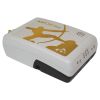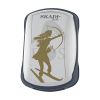Eos Arrow 200 RTK GNSS Receiver
The Eos Arrow 200 is a GNSS receiver capable of providing 1cm real-time accuracy on any Android, iOS and Windows mobile device.
Features
- Supports existing and future GNSS (GPS, GLONASS, Galileo, BeiDou)
- 100% Android, iOS, Windows compatible
- 1cm RTK real-time accuracy
- Free ground shipping
- Expedited repair and warranty service
- Lifetime technical support
- More
The World’s First RTK Receiver for Every Mobile Device
Designed for use with a broad range of mobile devices, from smartphones to tablets and notebook computers, the Eos Arrow 200 incorporates rock-solid, wireless Bluetooth technology that works smoothly with Android, iOS, and Windows devices, making it obsolete-proof and portable across platforms.
Consumer Choice of Mobile GIS Software
The Arrow 200 feeds 1cm RTK accuracy to every app on Android or iOS devices, including Google or Apple maps. The Arrow 200 works seamlessly with Esri Collector/ArcPad/ArcMobile, Fulcrum, AmigoCloud, TerraFlex, MapItFast, GeoJot, iCMTGIS and many more mapping apps.
All Satellites, All Signals
The Eos Arrow 200 incorporates premium features that place it among the highest-performing receivers in the world. It takes advantage of all existing satellite constellations (GPS, GLONASS, BeiDou, SBAS) as well as emerging and planned constellations (Galileo and QZSS) to deliver top-notch, 1cm RTK performance anywhere in the world when connected to an RTK Network or 10-15cm accuracy using OmniSTAR HP or G2.
The Ultimate in Worldwide High-Precision GNSS Technology
The Arrow 200 provides ultimate flexibility. Use one of OmniSTAR’s services to get 10cm real-time accuracy anywhere in the world. Collect data anywhere in the world using Eos’ free data collection program and post-process the data using free online processing services like PUS or AUSPOS to achieve centimeter accuracy anywhere.
- (1) Arrow 200 receiver with Arrow Smart Battery Pack
- (1) Dual-Frequency GNSS / LBand Precision Antenna
- (1) Large Antenna Mounting Plate
- (1) Two-section Short Antenna Cable for survey pole
- (1) Arrow Pole Mount Bracket
- (1) Range Pole Clamp
- (1) USB Data Cable
- (1) 12V International Power Supply for Arrow Smart Battery pack
- (1) Hard Shell Case
In The News
Eos Arrow receivers give GIS pros real-time data, solid connectability
For pros working in mapping, surveying and other GIS fields, quick, precise data are a must. And the key to getting those data is getting the right receiver. As a result, many turn to high-accuracy, multi-constellation receivers like the Arrow series built by Eos Positioning Systems. The series includes the Eos Arrow Lite GPS Receiver, Eos Arrow 100 GNSS Receiver and Eos Arrow 200 L1/L2 GNSS Receiver. The receivers are popular for many reasons: They have the flexibility to use multiple satellite constellations, offer real-time data transmission capability and can connect to any device via Bluetooth. The Arrow receivers use the United States’ GPS constellation of satellites, but they can just as easily link up with Russia’s GLONASS, China’s Beidou and Europe’s Galileo.
Read MoreMonitoring Mariculture in the Gulf of Alaska
The mariculture industry in the Gulf of Alaska has been steadily growing in recent years, guided by ongoing research to help refine farm location and cultivation practices. A subset of aquaculture, mariculture focuses on rearing organisms in the open ocean. In Alaska, finfish farming is illegal, so most farms cultivate kelp, oysters, or a combination of the two. These small, locally operated farms started popping up in the Gulf of Alaska in the early 1990s, when shellfish farming first became legal. Kelp farming did not begin to catch on in the state until 2016. Many of the coastal areas that have grown interested in mariculture are historically commercial fishing communities.
Read MoreSupplying Seattle’s Drinking Water: Using Data Buoys to Monitor the Cedar River Municipal Watershed
Providing clean, safe, and reliable drinking water for the 1.6 million people in the greater Seattle area is a top priority for Seattle Public Utilities (SPU). With limited water supplies, SPU dedicates considerable resources to maintain its watersheds and mountain reservoirs. About 70 percent of Seattle Water comes from the Cedar River Municipal Watershed , and the other 30 percent comes from the South Fork Tolt River Watershed . [caption id="attachment_39574" align="alignnone" width="940"] Data buoy in Chester Morse Lake . (Credit: Kevin Johnson / Seattle Public Utilities) [/caption] Jamie Thompson, a fisheries biologist at SPU, monitors aquatic ecosystems centered on fish listed under the U.S. Endangered Species Act (ESA).
Read More







































